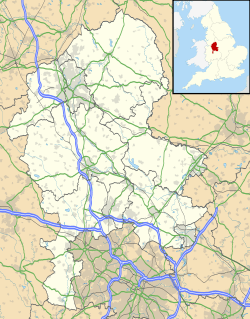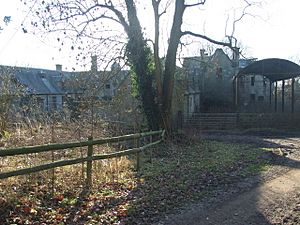Calwich Abbey facts for kids
| Monastery information | |
|---|---|
| Other names | Calwich Priory |
| Order | Benedictine |
| Established | c.1130 |
| Disestablished | 1532 |
| Site | |
| Location | near Ellastone, Staffordshire, England |
| Coordinates | 52°59′12″N 1°48′35″W / 52.9868°N 1.8097°W |
| Public access | Yes |
Calwich Abbey is the name for a special place in Ellastone, Staffordshire, England. It was first a priory (a type of monastery) in the Middle Ages. Later, two different large country houses were built on the same spot.
A Look Back: Calwich Priory
This site began around 1130 as a small religious house called a priory. It was linked to a bigger monastery, Kenilworth Priory. The priory was dedicated to a saint named St Margaret.
In 1349, Calwich Priory became independent. This meant it could make its own decisions and choose its own leader, called a prior. However, it was always a small and not very wealthy place. By 1530, only one religious person remained there. In 1532, the priory closed down. Its land and buildings were given to another monastery, Rocester Abbey.
By 1543, a family called the Fleetwoods bought the property. They changed the old priory buildings into a home for their family.
The Calwich Abbey Country Houses
Later, a man named Bernard Granville bought the estate from the Fleetwood family. He decided to knock down the old priory house. He then built a brand new house closer to a stream, which he turned into a beautiful lake.
Bernard Granville passed away in 1775 without children. He left the property to his nephew, John D'Ewes. John then took on the last name Granville. In 1826, he also left the estate to his nephew, Court D'Ewes, who also changed his last name to Granville.
This house was a popular place for famous people to visit. Important thinkers and artists like Erasmus Darwin, the composer Handel, writer Anna Seward, and philosopher Rousseau all spent time there.
In the 1840s, the Duncombe family bought the estate. They decided to rebuild the house again. Between 1849 and 1850, they constructed a new house on higher ground. It was built in a style called Jacobean, using stone and slate roofs.
Sadly, much of this grand house was taken down in 1927. Today, the remaining parts of the building and the old stables are in ruins, even though they are protected as historic sites. A small "fishing temple" building, located by the river, is still standing.
In May 2015, the Calwich Abbey Estate was put up for sale. In June 2015, it was announced that Garrick Sayers bought the property for £2 million.



